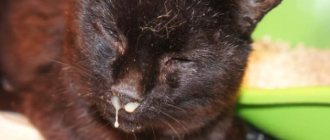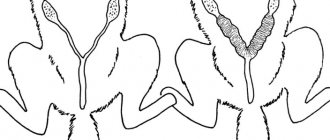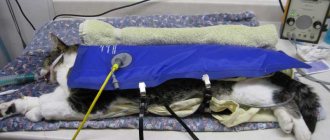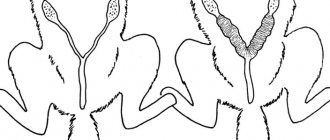17121Administration
Often, discharge from a cat on the outer labia is not considered normal and signals a problem with the animal’s health. Of course, you shouldn’t immediately panic and imagine a serious illness, because in some cases, discharge from the loop does not pose any danger.
But it won’t hurt to show your pet to a good veterinarian, since self-diagnosis is ineffective and is fraught with complications and consequences. Discharges can be very diverse :
- purulent;
- blood;
- watery;
- transparent;
- cloudy;
- white;
- gray;
- brown.
Discharge in a cat, which is a physiological norm
During heat, a cat secretes a clear fluid that goes unnoticed because the cat is constantly licking itself. Twenty days after mating, a pregnant cat secretes a little clear and thick mucus in her urine. This is part of the plug that clogs the cervix, necessary to protect the organ from infection.
In the sixth week of gestation, excess amniotic fluid is released. You need to be sure whether the cat is pregnant. If this is the case, then the release of a small amount of clear liquid is not a cause for concern.
A few hours before birth, white or yellowish discharge appears, sometimes slightly bloody. After the start of contractions, the amniotic fluid leaves, greenish or fawn, transparent.
Dangerous diseases
Some brown, pink, clear and white discharge from a cat indicates dangerous diseases in your beloved pet. If she is not helped in time, the disease will progress, and ultimately some ailments lead to death, infertility and many other complications. Most often, veterinarians identify 7 diseases that affect animals. Some diseases occur through the entry of bacteria into the urethra and urethra.
Pyometra
Most often, this disease appears in older cats. When 2-3 months pass after estrus and the cat has not been fertilized, bacteria begin to develop in the uterine area, which can enter the body long before the onset of estrus. The fact is that without caring for the sperm and the development of the fetus, cysts form. As a rule, the main symptom of bacteria in the body is strong discharge, which can appear both during and after estrus. You can avoid this by sterilizing your cat on time.
The disease can be provoked by deterioration of hygiene standards during estrus, childbirth or operations. Risk factors: low physical activity of the cat, susceptibility to disease, inflammation, uncontrolled mating and much more. Along with the discharge, the cat's belly is rounded (lack of pregnancy), severe thirst and frequent trips to the toilet, bad behavior due to poor health, disheveled fur, and so on.
As the disease progresses, loss of appetite, vomiting, and diarrhea appear. Discharge with this disease is brown or white-brown in color.
Uterine trauma
Inflammation and trauma to the uterus occur as a result of various diseases, as well as birth injuries. The disease can progress and be accompanied by discharge and pain. This disease is also fatal. The more the disease progresses, the larger and more abundant the discharge will be. They cannot be left unattended, because they will lead to the imminent death of the pet.
The cat will constantly lick the genital opening; when the disease reaches the last stage, the animal will no longer have time to constantly lick the pus. Purulent discharge will be very noticeable on the floor where the pet sits, on the back of the fur. As with the previous illness, there will be severe thirst and frequent trips to the toilet, but the cat will practically stop eating. The volume of the abdomen will increase at high speed and in a few hours can reach such a size that it will look extremely unnatural. The cat will breathe very heavily, the owner will certainly pay attention to this.
Note! Frequent urination occurs because the slightest accumulation of urine in the bladder causes very noticeable pain. Bacteria can settle in the uterus 1-2 months before manifestation.
What kind of discharge in cats is considered unhealthy?
Suspicions of a pathological process are caused by vaginal discharge of the following type and consistency:
- White, if they are not associated with pregnancy or childbirth, then indicate vaginitis or pyometra. An additional pathological symptom is an unpleasant odor.
- Yellow-colored or bloody, foul-smelling, occur with postpartum endometritis or miscarriage.
Be sure to read:
Why black spots appear in a cat’s mouth, lips, face or chin
Purulent discharge
The inflammatory process begins with the release of liquid transparent mucus, which gradually thickens, becomes opaque, first white, then acquires a creamy, yellowish, greenish or brown color. Darkening of the exudate is a sign indicating the death of mucosal tissue.
Your cat is bleeding: what to do?
When blood flows from the vagina in drops, clots, or along with exudate, it means that the cat has developed hematometra - a life-threatening illness.
The symptom indicates a violation of the integrity of blood vessels. In this case, urgent veterinary assistance is required.
Diagnostics
Diagnosing cat diseases is not difficult, since veterinary medicine has a wide variety of diagnostic techniques. Laboratory diagnostic methods are especially informative.
Most often, vaginal discharge is examined. A smear or scraping is taken. The obtained materials are examined by various laboratory methods (microscopy, cultural culture, etc.). Cultural culture allows not only to determine the type of bacteria, but also to select the most suitable antibiotic.
Blood is also taken for analysis. The study is carried out in different ways, depending on what disease is suspected. The most popular methods: ELISA, PCR.
In order to detect malignant neoplasms, ultrasound or X-ray examination with a contrast agent is used. In difficult cases, an MRI may be prescribed. But such a study can only be done in large veterinary clinics.
A cat has white uterine discharge: normal or pathological?
White genital discharge, if it is not associated with pregnancy or labor, is pus. Most often they occur due to decreased immunity as a result of the use of hormonal contraceptives or hormonal anti-inflammatory drugs.
Staphylococci are activated, which constantly live in the body and do not cause harm to health with a normally functioning immune system. Vaginitis develops.
Another cause of the disease is the consequences of mating with a cat infected with chlamydia, toxoplasma, feline immunodeficiency virus, and mycoplasma.
After a difficult birth, fragments of the placenta remain in the uterus, they fester, leading to endometritis. The most dangerous pathology that begins with white discharge is pyometra. The discharge becomes colored or stops. If additional symptoms appear - depression, pain in the enlarged abdomen, it means that pyometra has passed into the most dangerous - closed form. The pus does not come out, but accumulates inside the uterus.
In older animals, suppuration may be a symptom of a tumor process. The main reason for the occurrence of neoplasms is repeated hormonal disruptions caused by the termination of an unwanted pregnancy or the use of drugs to disrupt estrus.
First, a false pregnancy develops. The animal gets worried, begins to prepare the nest, and spoils the situation. She produces milk, but no kittens. Repeated imaginary tightness is dangerous because it triggers the process of development of neoplasms.
Be sure to read:
What can cause a cat's cheek to swell: causes of swelling and puffiness on the face under the eye
Care, maintenance and treatment of your pet
In order for treatment measures to bring positive results more quickly, owners need to provide the cat with proper care:
- Provide a secluded place for the animal, put a disposable sheet on the bed and change it regularly when it gets dirty.
- The room where the sick cat is located must be warm and free of drafts, and it must be ventilated regularly.
- During treatment, it is forbidden to let your pet go outside; its communication with other pets should be limited.
- The cat must have constant access to drinking water. If the animal refuses to drink or is too weak, you need to give it water yourself using a syringe, after removing the needle.
- During the illness, the animal should receive nutritious and easily digestible food. These can be meat broths, to which chopped meat, fermented milk products, cereals and vegetables are added in small quantities. On the advice of a veterinarian, you can purchase special medicated food so that the animal gains strength faster.
To protect your pet from diseases that lead to bleeding, you must adhere to the following preventive measures:
- If the cat is not intended for breeding, it makes sense to sterilize the pet. This will protect her from many diseases that occur in the genitourinary system. After the procedure, the cat should be regularly shown to the veterinarian for an ultrasound, this will help to better monitor the animal’s health.
- Get all necessary vaccinations and antihelminthic treatment in a timely manner to maintain the body's defenses.
- For mating, choose a healthy male cat; the owners of the male must document this.
- When giving birth to a cat, use sterile consumables and thoroughly treat your hands with antiseptics.
- If any unusual discharge occurs, you should take your cat to the veterinarian as soon as possible.
The measures described above will help not only prevent the development of the disease, but also, if necessary, show the cat to a specialist as soon as possible without wasting time.
Bloody discharge accompanied by a significant deterioration in the animal’s condition is a formidable sign indicating the development of severe pathology. There is no need to try to find the cause on your own, but take the cat to the veterinary clinic as soon as possible for examination and treatment.
Treatment of white discharge in cats
If leucorrhoea is accompanied by an unpleasant odor, this is a reason to contact a veterinarian. After a clinical examination and laboratory tests, the doctor assesses the general condition of the cat and prescribes treatment. prescribes treatment.
With timely treatment, it is possible to use conservative therapy methods. Vaginitis or open pyometra is treated with douching. The cat owner should ask a veterinarian or experienced felinologist how this is done.
Medicines based on furatsilin or chlorhexidine are taken into a rubber syringe and carefully squeezed into the vagina. At the same time, oral antibiotics or sulfonamides are prescribed.
The radical method of treatment is castration. Indications: closed pyometra, cancer, age over 6 years. In Russia, castration is called sterilization, although these are different operations.
Residents of high-rise buildings get a cat, but do not know what to do with it when it reaches sexual maturity. The call of nature, not supported by mating, causes torment for the pet and those around her. A reliable way to prevent it is to remove the uterus with ovaries and appendages at 8-10 months.
In this case, the cat will never have white or differently colored discharge from the loop. The disadvantage is the need to use expensive specialized food for sterilized cats to avoid obesity.
CAUSES
- Inflammatory process in the foreskin (balanoposthitis)
- Injuries/neoplasms in the foreskin
- Diseases of the urethral canal (infectious, traumatic, neoplasms)
- Bladder diseases (inflammation, stones)
- Diseases of the prostate gland (inflammation - prostatitis, or enlargement of the gland - hyperplasia, prostate cyst)
- Bleeding disorders
- Thrombocytopenia
- Urinary incontinence
Discharge is possible both for mild disorders that require treatment with local remedies, and for severe internal diseases that require drug therapy or surgical intervention.
In all cases, the best solution would be to consult and call a doctor for quick diagnosis and timely treatment.
Prevention is the key to health
To keep your pet healthy, you need to follow preventive measures. A few basic rules:
- Careful observation of changes in the animal’s appearance and behavior;
- Regular visits to the veterinary clinic for a professional examination of the animal;
- If the cat has already had illnesses, you need to use prophylactic agents in the form of tablets or drops;
- Limit your stay on the street in areas where there are many homeless animals;
- Examine your pet yourself and eliminate foods that may cause disease.
The period of pregnancy and after childbirth requires special attention: during these periods the body is more vulnerable to the emergence of dangerous diseases that are primarily associated with the uterus. For example, after giving birth, you can call a veterinarian to your cat’s home for an examination; in no case should you allow the cat to be in hygienically unsuitable places in the first hours and days after birth: the street, the basement, contaminated places in the house. The same rules must be followed during childbirth.











